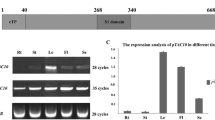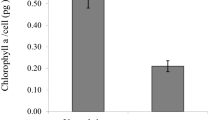Abstract
Regulation of gene expression in plastids may involve molecular components conserved from cyanobacteria-like ancestors. Among prokaryotes, genes are commonly regulated at the transcriptional level by `two-component' or `His-Asp' signal transducers, consisting of a `sensor kinase', which autophosphorylates at a conserved histidine residue, and a cognate response regulator, which is phosphorylated by the sensor kinase at a conserved aspartate residue. A putative His-Asp response regulator gene (trg1: transcriptional regulatory gene 1) has been identified in the estuarine raphidophytic alga Heterosigma akashiwo. The chloroplast-encoded trg1 is 693 bp in length, contains no introns, and yields a conceptual translation product of 231 amino acids, with a predicted mass of 27 kDa. Homology searches suggest that Heterosigma trg1 has an ompR-like identity within the DNA-binding His-Asp family of response regulators. trg1 contains both the phosphorylation and DNA-binding domains which are present in prokaryote response regulators. Quantitative competitive RT-PCR showed that Heterosigma trg1 is expressed at low levels (5 μg per g total RNA). In contrast, psbA (a photosystem II component) transcript is abundant (60 mg per g total RNA). Cell cycle analysis showed that psbA abundance oscillates in response to light but trg1 mRNA levels are invariant. We hypothesize that a His-Asp phosphorelay mechanism may affect chloroplast genome transcription in a manner similar to bacterial signal transduction pathways in which `sensor kinase' and cognate `response regulator' proteins interact.
Similar content being viewed by others
References
Bernard, C., de Marsac, N.T. and Thomas, J. 1994. An ompR gene in the plastid genome of Rhodella violacea. Plant Physiol. 106: 795-796.
Brandstatter, I. and Kieber, J.J. 1998. Two genes with similarity to bacterial response regulators are rapidly and specifically induced by cytokinin in Arabidopsis. Plant Cell 10: 1009-1019.
Bulow, S. and Link, G. 1988. Sigma-like activity from mustard (Sinapsis alba L.) chloroplasts conferring DNA-binding and transcription specificity to E. coli core RNA polymerase. Plant Mol Biol. 10: 349-357.
Cattolico, R.A., Boothroyd, J.C. and Gibbs, S.P. 1976. Synchronous growth and plastid replication in the naturally wall-less alga Olisthodiscus luteus. Plant Physiol. 57: 497-503.
Chang, C. and Meyerowitz, E.M. 1994. Eukaryotes have 'two component' signal transducers. Res. Microbiol. 145: 481-486.
Delaney, T.P. and Cattolico, R.A. 1989. Chloroplast ribosomal DNA organization in the chromophytic alga Olisthodiscus luteus. Curr. Genet. 15: 221-229.
Doran, E. and Cattolico, R.A. 1997. Photoregulation of chloroplast gene transcription in the chromophytic alga Heterosigma carterae. Plant Physiol. 115: 773-781.
Douglas, S.E. and Penny, S.L. 1999. The plastid genome of the cryptophyte alga, Guillardia theta: complete sequence and conserved synteny groups confirm its common ancestry with red algae. J. Mol. Evol. 48: 236-244.
Eisermann, A., Tiller, K. and Link, G. 1990. In vitro transcription and DNA binding characteristics of chloroplast and etioplast extracts from mustard (Sinapsis alba) indicate differential usage of the psbA promoter. EMBO J. 9: 3981-3987.
Gruissem, W. and Tonkyn, J.C. 1993. Control mechanisms of plastid gene expression. Crit. Rev. Plant Sci. 12: 19-55.
Hardison, L.K., Boczar, B.A. and Cattolico, R.A. 1995. psbA in the marine chromophyte Heterosigma carterae: evolutionary analysis and comparative structure of the D1 carboxyl terminus. Am. J. Bot. 82: 893-902.
Hoch, J.A. and Silhavy, T.J. (Eds.) 1995. Two-Component Signal Transduction, ASM Press, Washington, D.C., 488 pp.
Hughes, J.E., Neuhaus, H.G. and Link, G. 1987. Transcript levels of two adjacent chloroplast genes during mustard (Sinapsis alba L.) seedling development are under differential temporal and light control. Plant Mol. Biol. 9: 355-363.
Hwang, S., Kawazoe, R. and Herrin, D.L. 1996. Transcription of tufA and other chloroplast genes is controlled by a circadian clock in Chlamydomonas. Proc Natl. Acad. Sci USA 93: 996-1000.
Imamura, A., Hanaki, N., Umeda, H., Nakamura, A., Suzuki, A., Ueguchi, C. and Mizuno, T. 1998. Response regulators implicated in His-to-Asp phosphotransfer signalling in Arabidopsis. Proc. Natl. Acad. Sci USA 95: 2691-2696.
Kessler, U., Maid, U. and Zetsche, K. 1992. An equivalent to bacterial ompR genes is encoded on the plastid genome of red algae. Plant Mol. Biol. 18: 777-780.
Klein, U., de-Camp, J.D. and Bogorad, L. 1992. Two types of chloroplast gene promoters in Chlamydomonas reinhardtii. Proc Natl. Acad. Sci. USA 89: 3453-3457.
Kohata, K. and Watanabe, M. 1986. Synchronous division and the pattern of diel vertical migration of Heterosigma akashiwo (Hada) Hada (Raphidophyceae) in a laboratory culture tank. J. Exp. Mar. Biol. Ecol 100: 209-224.
Kohata, K. and Watanabe, M. 1989. Diel changes in the composition of photosynthetic pigments in Chattonella antiqua and Heterosigma akashiwo (Raphidophyceae). In: T. Okaichi, D.M. Anderson and R. Nemoto (Eds.), Red Tides: Biology, Environmental Science, and Toxicology, Elsevier Science Publishing, New York, pp. 329-332.
Koshland, D.E. Jr. 1993. The two-component pathway comes to eukaryotes. Science 262: 532.
Krupinska, K. 1992. Transcriptional control of plastid gene expression during development of primary foliage leaves of barley grown under a daily light-dark regime. Planta 186: 294-303.
Kubicki, A., Steinmuller, K. and Westhoff, P. 1994. Differential transcription of plastome-encoded genes in the mesophyll and bundle-sheath chloroplasts of the monocotyledonous NADP-malic enzyme-type C4 plants maize and Sorghum. Plant Mol. Biol. 25: 669-679.
Lerbs, S., Bräutigam, E. and Mache, R. 1988. DNA-dependent RNA polymerase of spinach chloroplasts: characterization of alpha-like and sigma-like polypeptides. Mol. Gen. Genet 211: 459-464.
Link, G. 1996. Green life: control of chloroplast gene transcription. BioEssays 18: 465-471.
Liu, B. and Troxler, R.F. 1996. Molecular characterization of a positively photoregulated nuclear gene for a chloroplast RNA polymerase sigma factor in Cyanidium caldarium. Proc. Natl. Acad. Sci. USA 93: 3313-3318.
Mayfield, S.P., Yohn, C.B., Cohen, A. and Danon, A. 1995. Regulation of chloroplast gene expression. Annu. Rev. Plant Physiol. Plant Mol. Biol. 46: 147-166.
McIntosh, J. and Cattolico, R.A. 1978. Preservation of algal and higher plant ribosomal RNA integrity during extraction and electrophoretic quantitation. Anal. Biochem. 91: 600-612.
Mizuno, T. 1997. Compilation of all genes encoding two-component phosphotransfer signal transducers in the genome of Escherichia coli. DNA Res. 4: 161-168.
Mizuno, T., Kaneko, T. and Tabata, S. 1996. Compilation of all genes encoding bacterial two-component signal transducers in the genome of the cyanobacterium Synechocystis sp. strain PCC 6803. DNA Res. 3: 407-414.
Nakano, T., Murakami, S., Shoji, T., Yoshida, S., Yamada, Y. and Sato, F. 1997. A novel protein with DNA binding activity from tobacco chloroplast nucleoids. Plant Cell 9: 1673-1682.
Pao, G.M., Lam, R., Lipschitz, L.S. and Saier, M.H.J. 1994. Response regulators: structure, function, and evolution. Res. Microbiol. 145: 356-362.
Pao, G.M. and Saier, M.H. Jr. 1995. Response regulators of bacterial signal transduction systems: selective domain shuffling during evolution, J. Mol. Evol. 40: 136-154.
Parkinson, J.S. and Kofoid, E.C. 1992. Communication modules in bacterial signaling proteins. Annu. Rev. Genet. 26: 71-112.
Quon, K.C., Marczynski, G.T. and Shapiro, L. 1996. Cell cycle control by an essential bacterial two-component signal transduction protein. Cell 84: 83-93.
Reith, M.E. and Cattolico, R.A. 1985. Chloroplast protein synthesis in the chromophytic alga Olisthodiscus luteus. Plant Physiol. 79: 231-236.
Reith, M. and Cattolico, R.A. 1986. Inverted repeat of Olisthodiscus luteus chloroplast DNA contains genes for both subunits of ribulose-1,5-bisphosphate carboxylase and the 32 000-dalton QB protein: phylogenetic implications. Proc. Natl. Acad. Sci. USA 83. 8599-8603.
Reith, M. and Munholland, J. 1993. A high-resolution map of the chloroplast genome of the red alga Porphyra purpurea. Plant Cell 5: 465-475.
Reynolds, A.E., McConaughy, B.L. and Cattolico, R.A. 1993. Chloroplast genes of the marine alga Heterosigma carterae are transcriptionally regulated during a light/dark cycle. Mol. Mar. Biol. Biotechnol. 2: 121-128.
Sakai, H., Aoyama, T., Bono, H. and Oka, A. 1998. Two-component response regulators from Arabidopsis thaliana contain a putative DNA-binding motif. Plant Cell Physiol. 39: 1232-1239.
Satoh, E., Watanabe, M.M. and Fujii, T. 1987. Photoperiodic regulation of cell division and chloroplast replication in Heterosigma akashiwo. Plant Cell Physiol. 28: 1093-1099.
Schaller, G.E. 1997. Ethylene and cytokinin signalling in plants: the role of two-component systems. Essays Biochem 32: 101-111.
St. Amand, D., Pottage, C., Henry, P. and Fahnestock, M. 1996. Method for quantitation of low-abundance nerve growth factor in human nervous tissue using competitive reverse transcription polymerase chain reaction. DNA Cell Biol. 15: 415-422.
Stock, A.M., Martinez-Hackert, E., Rasmussen, B.F., West, A.H., Stock, J.B., Ringe, D and Petsko, G.A. 1993. Structure of the Mg 2 C-bound form of CheY and mechanism of phosphoryl transfer in bacterial chemotaxis. Biochemistry 32: 13375-13380.
Suzuki, T., Imamura, A., Ueguchi, C. and Mizuno, T. 1998. Histidine-containing phosphotransfer (HPt) signal transducers implicated in His-to-Asp phosphorelay in Arabidopsis. Plant Cell Physiol. 39: 1258-1268.
Tanaka, K., Oikawa, K., Kuroiwa, H., Kuroiwa, T. and Takahashi, H. 1996. Nuclear encoding of a chloroplast RNA polymerase sigma subunit in a red alga. Science 272: 1932-1935.
Throndsen, J. 1996. Note on the taxonomy of Heterosigma akashiwo (Raphidophyceae). Phycologia 35: 367.
Tiller, K. 1993. Sigma-like transcription factors from mustard (Sinapsis alba L.) etioplast are similar in size to, but functionally distinct from, their chloroplast counterparts. Plant Mol. Biol. 21: 503-513.
Tiller, K., Eisermann, A. and Link, G. 1991. The chloroplast transcription apparatus from mustard (Sinapis alba L.). Eur. J. Biochem. 198: 93-99.
Troxler, R.F., Zhang, F., Hu, J. and Bogorad, L. 1994. Evidence that sigma factors are components of chloroplast RNA polymerase. Plant Physiol 104: 753-759.
Valentin, K., Fischer, S. and Cattolico, R.A. 1998. The chloroplast bchI gene encodes a subunit of magnesium chelatase in the marine heterokont alga Heterosigma carterae. Eur. J. Phycol. 33: 113-120.
Volz, K. 1993. Structural conservation in the CheY superfamily. Biochem. Wash. 32: 11741-11753.
Yamada, H., Hanaki, N., Imamura, A., Ueguchi, C. and Mizuno, T. 1998. An Arabidopsis protein that interacts with the cytokinin-inducible response regulator, AAR4, implicated in the His-Asp phosphorelay signal transduction. FEBS Lett. 436: 76-80.
Author information
Authors and Affiliations
Rights and permissions
About this article
Cite this article
Jacobs, M.A., Connell, L. & Cattolico, R.A. A conserved His-Asp signal response regulator-like gene in Heterosigma akashiwo chloroplasts. Plant Mol Biol 41, 645–655 (1999). https://doi.org/10.1023/A:1006394925182
Issue Date:
DOI: https://doi.org/10.1023/A:1006394925182




